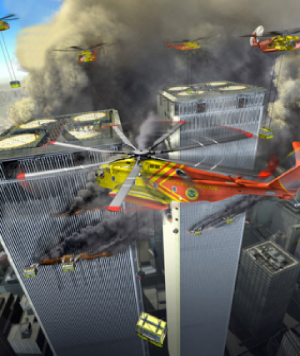By Dan Goodwin President / Skyscraper Defense, Inc.
America’s authority on high-rise firefighting, Deputy Chief F.D.N.Y. (Ret.) Vincent Dunn recently asked, “Are Architects, Engineers, and Code writing officials friends of the firefighters?” That’s a great question.
TALLER SKYSCRAPERS
Have we forgotten what happened on 9/11? I certainly haven’t and I can’t imagine the millions that currently live and work in towering skyscrapers have forgotten either. Nevertheless, many architects seem to embrace the belief that 9/11 was an anomaly, like it will never happen again. When I hear that, my father’s words flash through my head…
“Hardly ever doesn’t mean never. It just means hardly ever.”
TALLER IS NOT THE PROBLEM
Developers could build skyscrapers to the edge of outer space for all I care. However, whatever the design, it must accommodate the building occupants, and that includes their safety. Buildings with tops that inhibit or deny egress make no sense. What happens if an emergency occurs and the only escape is up, to the roof? How will we rescue the people?
WEAK CODES IS THE PROBLEM
If Code Officials were our friends, they would require all skyscrapers to have at least one helicopter pad. Taller skyscrapers, like the new One World Trade Center (a.k.a. the Freedom Tower) would be required to have multiple pads. However, if what’s on the internet is accurate, the new World Trade Center tower, the single building replacement to the Twin Towers and soon to be the tallest skyscraper in the United States, will not even have one helicopter pad. Perhaps the developers are following the lead of the New York fire department. F.D.N.Y., America’s largest fire department and the people responsible for rescuing people from the more than 5000 high-rise buildings in New York City, does not have a single helicopter in its arsenal.
Now that’s criminal!
LARGER OPEN SPACES
Thirteen months before 9/11, Vincent Dunn sounded an alarm when he wrote in his August 2000 newsletter… “The best-kept secret in America’s fire service is that firefighters cannot extinguish a fire in a 20- or 30-thousand-square-foot open floor area in a high-rise building. A fire company advancing a 2 1/2-inch hoseline with a I 1/4-inch nozzle discharges only 300 gallons per minute and can extinguish only about 2,500 square feet of fire. The reach of the streams is only 50 feet. A modern open-floor office design, with cubicle work stations and dwarf partitions that do not extend to the ceiling, allows fire to spread throughout an entire 100- x 200-foot floor area. A fully involved, free burning 20,000-square-foot floor area cannot be extinguished by a couple of firefighters spraying a hose stream from a stairway. City managers and department chiefs will not admit this to the public if they want to keep their jobs. But every fireground commander knows this is a fact.”
Nonetheless, engineers are creating open spaces even larger than the original World Trade Centers, which had 40,000 sq feet of open space on most floors. According to Popular Science, the new World Trade Center tower will have the open space plan favored by corporate tenants – 35,000 to 52,000 square feet (depending on the floor), broken only by a central corridor. Considering the concerns raised by Mr. Dunn, one has to question the wisdom of ‘approving’ large open spaces in tall buildings.
REFUGE CENTERS
If our plan is to continue constructing tall buildings, we need to incorporate ‘refuge centers’ on various floors. Countries in Asia require entire floors be set aside for that purpose, and we should follow their lead. As described in The Skyscraper Defense Act, these refuge centers should be equipped with their own independent ventilation, oxygen, water, and sprinkler system. They should be constructed with blast resistant floors, walls, ceilings, windows, and doors. The cost could be borne by tax incentives, reductions in insurance premiums, and cash flow generated by the room itself such as rent for use as a conference center. However, again according to Popular Science, full-scale refuge centers are not in the plans for the new World Trade Center tower. Rather, ‘refuge areas’ will be limited to stairwell landings large enough for people to wait for assistance. Based on the lesson of 9/11, the developers, architects, engineers, and code writers, are not acting in the best interest of the building occupants. Nor are they acting in the best interest of the firefighters whose job it will be, should an emergency occur, to find the people trapped inside the skyscraper.
EXTERNAL RESCUE ELEVATORS
What if an airplane’s only means of egress was the door through which you boarded? Given what we know about flying, my bet is you would feel a bit claustrophobic, like you had entered a potential human death trap. However, that’s what occurs when entering a towering skyscraper, particularly when moving beyond the reach of fire ladders. Why not address this shortcoming with ‘emergency evacuation stations’ near windows that open upon the arrival of an ‘external rescue elevator’. In an emergency, rescue elevators not only would serve as evacuation vehicles but also provide a means to send equipment and firefighters to hotspots.
INDEPENDENT AIR SUPPLY
According to the magazine, Fire Engineering, most fire fatalities stem from the inhalation of toxic gases, such as carbon monoxide and cyanide, emitted from polyurethane foam, melamine, abs (plastic pipe), and nylon. A single seat cushion is sufficiently toxic to poison an entire room. When inhaled in a low-oxygen environment, cyanide has a 10-fold increase in toxicity, enough to cause unconsciousness within 30 seconds.
Out of fear of breathing toxic gases, a firefighter would never enter a burning building unless he or she is in possession of a self-contained breathing apparatus. Physical exertion, such as what occurs when carrying hoses and extra oxygen tanks up flights of stairs, only exacerbates the problem. Since building occupants have the potential of being exposed to the same lethal fumes, they should also have access to oxygen. Equipping each floor with its own independent power and air supply not only protects the occupants but also provides the firefighters a means to refill their tanks. If airlines are required to carry oxygen, why not skyscrapers where the problem is no less severe?
FRIEND OR FOE?
One would think if architects, engineers, and code writing officials were truly our friends, they would bend over backward to assure the safety of everyone inside a tall building. However, they act as if their only interest is the bottom line. Make no bones about it, leasing space in skyscrapers is a very profitable business. It’s about square footage and quarterly profits. And, anyone who gets in the way, including the firefighter’s union, is viewed as a threat to their business model.
9/11 taught us that a firefighter’s life is on the line when charging up the stairs inside a burning building. We now know that even steel framed buildings have the potential of collapsing because steel connections have a limited fire rating. Anything beyond an hour starts getting skeptical. Anything after two becomes suspect. Anything after three and you’re on your own.
Don’t get me wrong, I love skyscrapers as much as the next person. However, if we’re going to be constructing skyscrapers a quarter mile or more into the sky, we should factor worst-case scenarios into the safety plan. Building occupants and emergency workers deserve to know every possible precaution has been taken. Otherwise, we’re doomed to repeat history.
WHO SPEAKS FOR THE FIRE SERVICE?
At a lecture given by Vincent Dunn, a firefighter asked, “Who speaks for the fire service? Where does the official voice for the firefighter come from?” That’s another great question. In a large-scale fire and collapse, architects turn to the American Institute of Architects (AIA) for an official explanation as to what happened. Engineers consult with the Society of Civil Engineers (SCE) to obtain an official engineering explanation. Code officials have associations that provide an official view of a building disaster.
But what about firefighters? Where do they turn?
The answer was provided by another firefighter attending the lecture. “Chief, I know where the firefighter goes to for an official explanation when firefighters are killed. When firefighters are killed, we go to the widows of firefighters. The families of dead firefighters are the voice of the fire service.”




